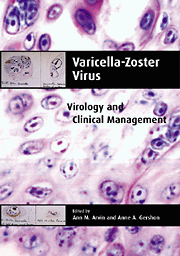Book contents
- Frontmatter
- Contents
- List of contributors
- Preface
- Introduction
- Part I History
- Part II Molecular Biology and Pathogenesis
- 2 Molecular evolution of alphaherpesviruses
- 3 DNA replication
- 4 Viral proteins
- 5 Pathogenesis of primary infection
- 6 Pathogenesis of latency and reactivation
- 7 Host response to primary infection
- 8 Host response during latency and reactivation
- 9 Animal models of infection
- Part III Epidemiology and Clinical Manifestations
- Part IV Laboratory Diagnosis
- Part V Treatment and Prevention
- Index
- Plate section
2 - Molecular evolution of alphaherpesviruses
from Part II - Molecular Biology and Pathogenesis
Published online by Cambridge University Press: 02 March 2010
- Frontmatter
- Contents
- List of contributors
- Preface
- Introduction
- Part I History
- Part II Molecular Biology and Pathogenesis
- 2 Molecular evolution of alphaherpesviruses
- 3 DNA replication
- 4 Viral proteins
- 5 Pathogenesis of primary infection
- 6 Pathogenesis of latency and reactivation
- 7 Host response to primary infection
- 8 Host response during latency and reactivation
- 9 Animal models of infection
- Part III Epidemiology and Clinical Manifestations
- Part IV Laboratory Diagnosis
- Part V Treatment and Prevention
- Index
- Plate section
Summary
Overview
Most modern virology revolves around determination of gene function. As a result, narrow perspectives abound – focused, for example, on a single host, a single virus, a single gene, a single motif. Work on viral evolution provides a constrasting perspective, where single entities take their place as equals among myriad others. It tells us what viruses share, and therefore what their history has been over broad sweeps of time. It tells us what is old and what is new, what is general and what is specific, what has happened once and what many times, which hurdles have been successfully overcome by different routes and which thus far only by one. Understanding viral evolution thus provides a context in which to view the origins, pervasiveness and flexibility of viral functions and the forces that have operated to shape viruses.
One feature that is pivotal to understanding the evolution of herpesviruses is their high degree of host specificity. Most herpesviruses infect a single species in nature, and a single animal species may be host to several distinct herpesviruses. This has long implied that herpesviruses have evolved in association with their hosts, and that interspecies spread may be relatively unimportant. Phylogenetic studies have generally confirmed this supposition, and have allowed a timescale to be inferred for herpesvirus evolution from knowledge about the evolution of their hosts.
In the context of herpesvirus evolution, the theme of this chapter is limited. Extant mammalian α-herpesviruses share the great majority of their gene functions and, according to current understanding, have histories as distinct lineages of up to 75 million years. Avian α-herpesviruses take the timescale back another 40 million.
- Type
- Chapter
- Information
- Varicella-Zoster VirusVirology and Clinical Management, pp. 25 - 50Publisher: Cambridge University PressPrint publication year: 2000
- 5
- Cited by



